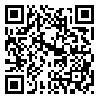Wed, Jul 16, 2025
[Archive]
Volume 18, Issue 3 (11-2004)
Med J Islam Repub Iran 2004 |
Back to browse issues page
Download citation:
BibTeX | RIS | EndNote | Medlars | ProCite | Reference Manager | RefWorks
Send citation to:



BibTeX | RIS | EndNote | Medlars | ProCite | Reference Manager | RefWorks
Send citation to:
TAVAKOLI M B. RADIOACTIVE DISCHARGE FROM PATIENTS WITH THYROID CANCER UNDER 131I TREATMENT AND ITS SAFE DISPOSAL TO PUBLIC DRAINAGE. Med J Islam Repub Iran 2004; 18 (3) :273-276
URL: http://mjiri.iums.ac.ir/article-1-602-en.html
URL: http://mjiri.iums.ac.ir/article-1-602-en.html
From the Department of Medical Physics and Medical Engineering, School of Medicine, Isfahan UniversityOf Medical Sciences, Isfahan, Iran , mbtavakoli@mui.ac.ir
Abstract: (4007 Views)
The treatment of thyroid cancer using an unsealed source of radioactive materials
is usually associated with a large amount of 131I. A major problem for hospital admission
of these patients is the waste disposal which requires protection of the public.
152 patients with thyroid cancer admitted to the nuclear medicine department of
Said AI- Shohada Hospital for UI I treatment were studied. 1311 excreted from these
patients during isolation was calculated. Exposure from patients were measured using
a Victorian 190F survey dosimeter.
More than 70 percent of the administered 131I was excreted after 24 hours, 90
percent after 48 hours and 96 percent after 72 hours of isolation. The mean biological
half life of 1311 in patients with thyroid cancer was found to be 13.9±1.9 hours. There
was no significant difference between the mean effective half life in the patients related
for the first time and second time at 95 percent significance level.
The results of this study showed that the difference in the discharge rate of 1311
from patients with thyroid cancer receiving first and second treatment was not significant.
The mean discharge rate after the first 24 hours was more than 70%, and it was
more than 96% after the third 24 hours of drug administration. The results can be used
to design safe collecting and discharge methods of the wastes.
Type of Study: Original Research: Basic Science in Medicine |
Subject:
Medical Physics and Radiation Therapy
Send email to the article author
| Rights and permissions | |
 |
This work is licensed under a Creative Commons Attribution-NonCommercial 4.0 International License. |





